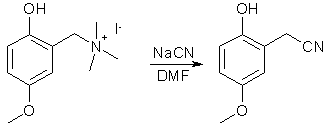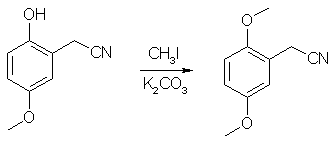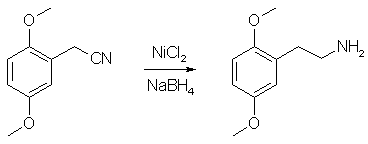Mannich reaction route to 2,5-dimethoxyphenethylamine (2C-H)by Assholium2-Hydroxy-5-Methoxy-benzyltrimethylammonium iodide
Place 124 g of p-methoxyphenol in a round-bottomed flask (placed in cold water-bath) with addition funnel and stirrer. Add 173 ml 29% aqueous dimethylamine (methoxyphenol completely dissolved). Drop by drop add 110 ml of 27% formaline, the temp was maintaned near 25-30°C during the addition. The reaction mixture was stirred another hour, and all volatiles completely removed in vacuo. To dark oily residue was added 600 ml of acetonitrile (IPA may be used) containing 120 ml of methyl iodide. Exotermic reaction appears; use reflux condensor for minimum loss of CH3I. Best temp range for quaternisation 30-40°C; below 15°C reaction almost stops. Keep the reaction mixture in water bath (30-50°C) for 3 hrs, then leave in cold a place overnight. Deposited slighly yellow crystals filtered off, mother liquor reduced twice in volume under vacuo, and cooled once more. After filtering of second crop, the yield of quaternary salt is near 200g, or 62% theory. 2-hydroxy-5-methoxy-benzylcyanide
Place 200 ml of 40% NaCN soln (d=1.4) in flask, (equipped with addition funnel, mechanic stirrer and 50-cm glass tube as air condenser) and add 300 ml of DMF. Dissolve 200 g (0.62 mole) of quat. salt in 200 ml of DMF, and place this soln in addition funnel. Heat about 80-90°C and at this temp drop by drop add soln of quat. salt to DMF suspension of cyanide (last not completely dissolved). Do it under good fume hood during 30-40 min. Strong evolution of trimethylamine observed. When addition complete, stir another 1 hour at 80-90°C. After cooling homogeneous dark reaction mixture poured in 2 L of water and extract with 4-5 150 ml portions of chloroform (or methylene chloride). Pooled extract was washed once with brine and quickly dried by shaken with anhydrous Na2SO4. Chloroform was distilled off under water pump vacuum; and then was distilled off DMF, taken by chloroform extraction. The residue crystallizes upon cooling, 62-65 g of 2-hydroxy-5-methoxybenzyl-cyanide (62%). Used as such for the next step. With hindered phenols as 2,6-dimethoxyphenol and 2,6-dimethylphenol cyanide, exchange of the quaternized mannich base succesfully runs in water. In this case (with the p-methoxyphenol derivative) using aqueous cyanide lead to massive charring, thus DMF was used. DMSO would probably also work. 2,5-Dimethoxy-benzylcyanide
65 g (0.386 mole) of the previously obtained benzylcyanide, 400ml acetone and 100g of finely powdered K2CO3 was placed in RB flask equipped with an addition funnel, stirrer and reflux condenser). As PTC catalyst added 10 ml PEG-400 (polyethyleneglycol). To this mixture added 50 ml of methyl iodide drop by drop during 1h and mixture refluxed 14h with stirring. Initial dark color changes to light yellow; after cooling the solid salts was filtered off, washed with fresh acetone, to acetone 50ml water added and solvent removed in vacuo. Residue was extracted with CH2Cl2, extract dryed with Na2SO4, and solvent removed, resulting in 62 g of 2,5-diMeO-benzylcyanide, 91% yield (bp 115°C at 2mmHg, mp 53-55°C, white needles from IPA). 2,5-Dimethoxyphenylethylamine (2C-H)
Place 24 g (0.136 mol)of 2,5-dimethoxybenzylcyanide in flask, add 300 ml of 96% ethanol, and then 15 g of anhydrous NiCl2 (or 20 g dihydrate). Under magnetic stirring add 38 g (1 mol) of NaBH4 in small portions during 30-40 min. Immediately black color appears. Temp. during the addition rose to 40-50°C, and evolution of H2 observed. When addition of borohydride complete, stir another 3 hrs at 40-50°C, and after cooling 200 ml of 3N HCl added into the reaction mixture and that stirred till the black precipitate dissolved. After removal of ethanol under vacuo and extracting of unreacted nitrile with ether or hexane, the aqueous layer made alkaline with conc ammonia soln and then extracted with ether 3 times. Combined extracts washed with brine, dried over MgSO4 and evaporated. Obtained oil (2C-H) (19g, 73% yield) used as such for bromination. Unreacted cyanide can be isolated from the etheral washes of the reaction mixture and reduced once more, this will improve conversion of the benzyl cyanide to the phenethylamine to near 90-95%. |